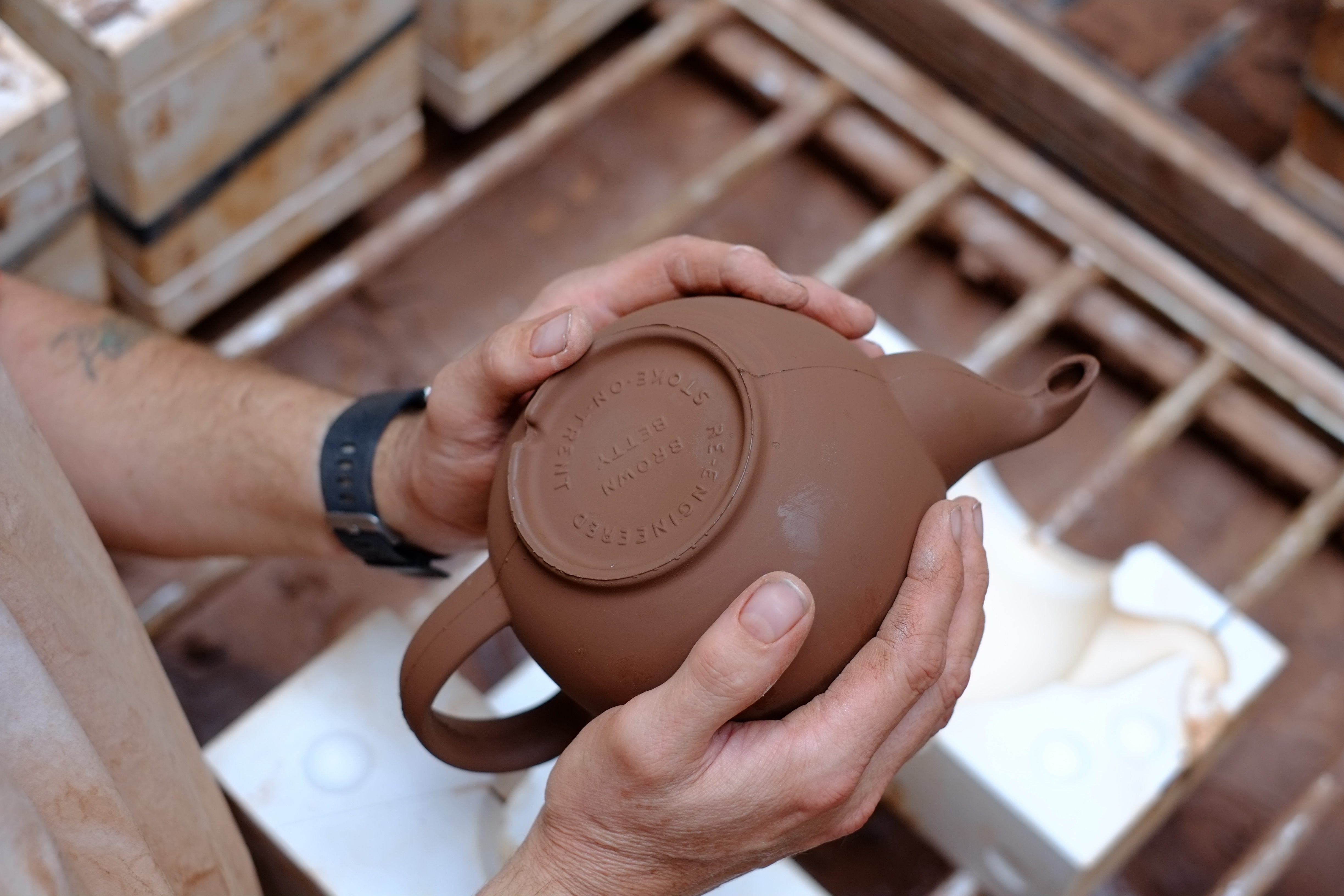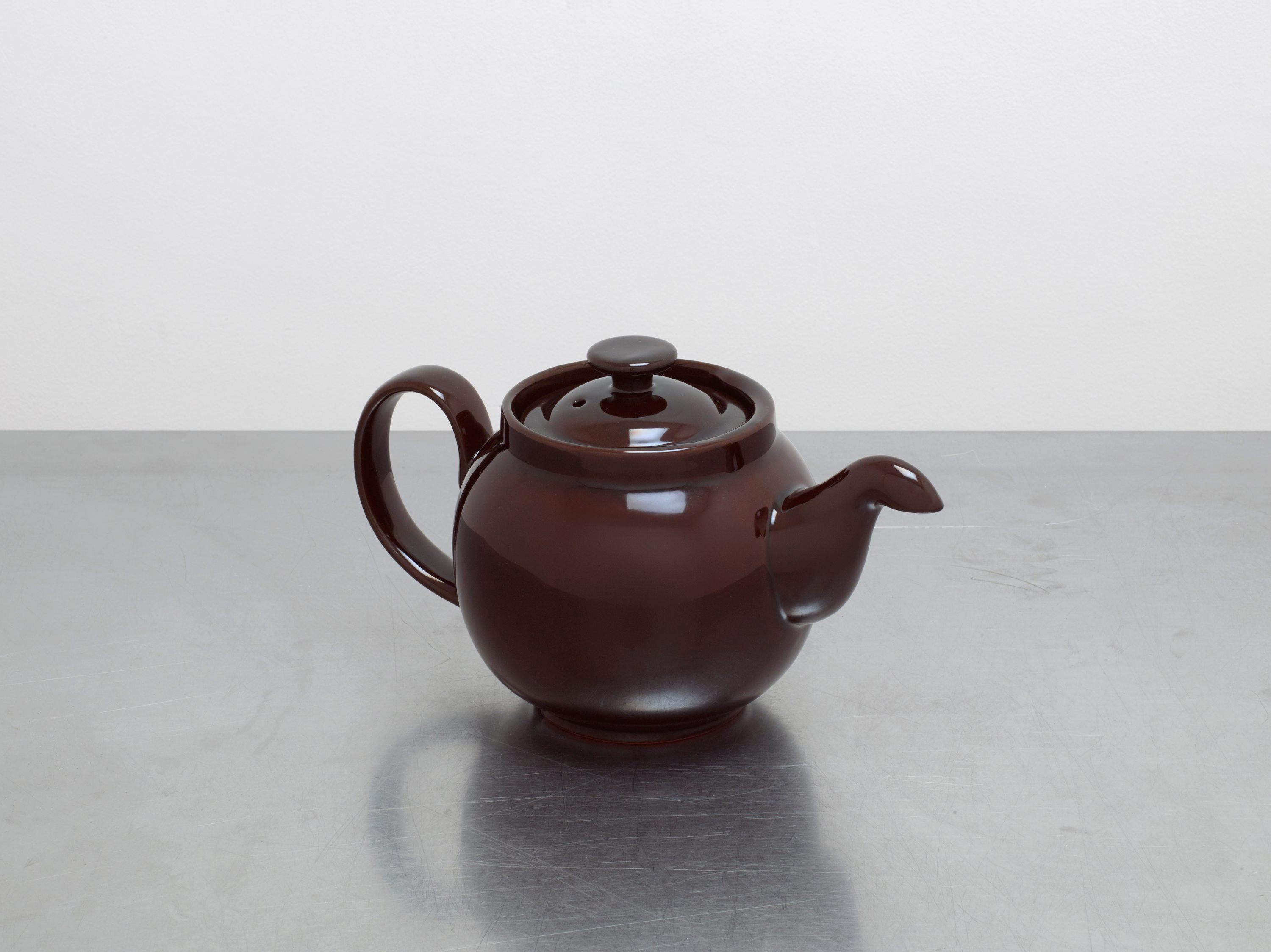Britain’s Iconic Brown Betty Teapot Gets a Redesign
A new version of the humble teapot reintroduces features from the past.

Although you might not know it by name, the Brown Betty is the quintessential British teapot. According to Stephen Murray of Cauldon Ceramics, it’s beloved for its ability to brew a good cup of tea, almost every time. “When people picture iconic images of the U.K., there’s usually the Union Jack, the London Eye, a red London bus,” he says. “Often you’ll find a Brown Betty teapot in there too.”
The style of teapot known as the Brown Betty has existed since the mid-19th century. Its brown glaze is praised for its heat-retaining and stain-hiding abilities, and some tea-lovers theorize that its globed shape allows for a better diffusion of loose leaf tea. However, despite their ubiquity, it’s hard to find out much about the Brown Betty’s past, or how it received its mysterious name. According to ceramicist Ian McIntyre, “It’s one of those objects that everyone recognizes, but nobody knows why it’s relevant. It disappears into everyday life.” McIntyre himself spent three years researching, then reengineering, the Brown Betty, putting the spotlight on an under-appreciated piece of British design.

Researching industrial ceramics innovations for his PhD, McIntyre’s interest in the Brown Betty began with its material, which links it back to the beginning of the British ceramics industry. When tea first arrived in England in the mid-17th century, it was prohibitively expensive for all but society’s elite. Imported Chinese wares for serving tea, particularly Yixing red stoneware, became luxury items. Realizing that the local red clay could offer an economical alternative, two brothers from Holland, John Philip and David Elers, established a pottery in Bradwell, Staffordshire.
That red clay, Etruria Marl, was used for Britain’s first domestically made teapots. The following centuries cemented the area as the center of the ceramics industry, and today, it’s still referred to as the Potteries.
While he doesn’t know who made the first Brown Betty, McIntyre does know that local ceramic firms first developed glazes for redware teapots in the mid-18th century. Rather than being associated with one designer or Staffordshire factory, the Brown Betty evolved for “purely functional” reasons, he says, especially as tea became affordable for more of British society. As a result, Brown Betty pots became associated with the working class. According to Ben Miller, assistant curator of ceramics at the Potteries Museum & Art Gallery, “everybody had these big brown pots. If you went round to someone’s house, you’d be served tea and that’s just how society worked.”

But it was the popularization of creamware and bone china that made the Potteries famous throughout the world, not humble redware. The stories of pottery makers such as Minton, Spode, and Wedgwood dominate the history books. Yet McIntyre couldn’t find anything written about the Brown Betty. The Potteries Museum doesn’t even have a Brown Betty on display.
McIntyre describes the redware industry as “running alongside the whiteware industry, but in a much more undocumented, vernacular way, because it wasn’t seen as worthy as writing into history.” The Brown Betty’s popularity with the working class may also have contributed to their invisibility. “The only real awareness that this style of teapot was produced in such large quantities were the sales catalogs going out all around the world,” he says.
In these 19th-century export catalogs, McIntyre spotted unadorned Brown Betty-style pots, made by a variety of different companies, alongside ever-changing fashionable wares. Surprising inventiveness went into the making of these “big brown pots.” McIntyre discovered that the company Alcock, Lindley, and Bloore patented a Brown Betty with a non-drip spout and a locking lid in the 1920s. By the middle of the decade, an estimated half a million Brown Betty-style pots were made every week.

However, the more McIntyre looked into the history of the Brown Betty, he realized that changing production processes and a shift to overseas manufacture resulted in an over-simplified Brown Betty. Seen in the later 20th century as a heritage product, manufacturers focused on the way it looked, rather than “the details that made it so successful,” he says. So McIntyre decided to reengineer the design, reintroducing innovations from the past, while adding a few of his own.
But then, McIntyre discovered the Cauldon Ceramics company was still hand-making redware teapots in Stoke-on-Trent. According to current owner Murray, Cauldon Ceramics was established in 2005 by the late Zamir Shaikh, who grieved the demise of the locally made Brown Betty. (These days, the ceramics industry in Staffordshire is a fraction of its former size.) “A lot of the companies that had been manufacturing the Brown Betty in the past had gone out of business, and I think he wanted to carry it on,” Murray says. After an introduction was brokered by the British Ceramics Biennial, one of the funders of McIntyre’s PhD, the ceramicist and ceramics company teamed up to develop and produce improved Brown Bettys.

By the time Murray took over Cauldon Ceramics in 2017, the project was well underway. “I just thought what [McIntyre] was doing was a fantastic opportunity for us,” he says. But there were a number of challenges. For one thing, he had to work directly with the local clay, rather than combining it with other ingredients as subsequent generations of ceramic makers did.”We work with a natural material, dug out of the ground in Stoke-on-Trent,” explains Murray.
McIntyre’s new Brown Betty also had to be made in a factory of six workers making hundreds of teapots each week. Features such as Alcock, Lindley and Bloore’s locking lid originally benefited drinkers, stopping the lid falling out when the pot is lifted for pouring. McIntyre also redesigned the lid so it could sit inside the pot when inverted, allowing the teapots to be stacked, saving space within the small factory. Keeping the teapot’s usefulness at the forefront of his mind, he also introduced a removable metal strainer for loose leaf tea.

The process gave both McIntyre and Murray new respect for the Brown Betty’s intricacies, particularly the reintroduced non-drip spout. “It took me months and months to figure out why the spout wasn’t working,” McIntyre laughs. “I thought I was copying the original quite accurately.” A kink in the spout, left over from the casting process, allowed tea to dribble down the outside while pouring. While the kink simply needed to be softened down with a sponge during the manufacturing process, this tiny detail delayed the design’s commercial release by a year, finally going on sale in 2018. But it turned out to be worth it. The Reengineered Brown Betty Teapot nabbed a nomination for the Beazley Designs of the Year by London’s Design Museum, and will feature in the upcoming exhibition FOOD: Bigger than the Plate at the Victoria and Albert Museum.
Nevertheless, it’s nearly impossible for British manufacturers to compete with the price of teapots manufactured in East Asia. While most of the sales of the new Brown Betty have been to Cauldon Ceramic’s traditional export markets, Murray is pleased to note increased sales in the United Kingdom. Hopefully, the redesigned Brown Betty teapot will once again earn the appreciation of a nation of tea-drinkers.
Gastro Obscura covers the world’s most wondrous food and drink.
Sign up for our regular newsletter.


























Follow us on Twitter to get the latest on the world's hidden wonders.
Like us on Facebook to get the latest on the world's hidden wonders.
Follow us on Twitter Like us on Facebook